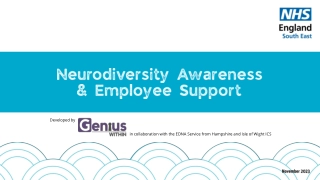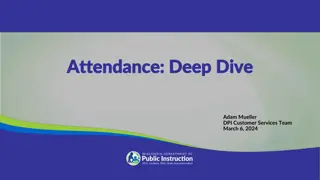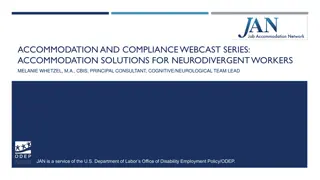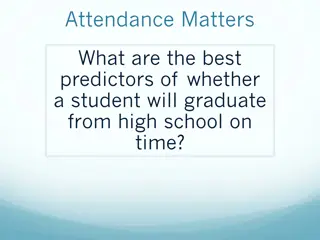Creating an Inclusive School Culture for Neurodivergent Students: Tips for Improved Attendance
Neurodiversity encompasses a range of brain differences, leading to neurodivergence among students. Understanding neurodivergence, common challenges, and practical tips based on research can help foster an inclusive school environment. Consider areas of struggle, strengths, physical health overlaps, various diagnoses, and the connection to Special Educational Needs to support neurodivergent students effectively.
Download Presentation

Please find below an Image/Link to download the presentation.
The content on the website is provided AS IS for your information and personal use only. It may not be sold, licensed, or shared on other websites without obtaining consent from the author.If you encounter any issues during the download, it is possible that the publisher has removed the file from their server.
You are allowed to download the files provided on this website for personal or commercial use, subject to the condition that they are used lawfully. All files are the property of their respective owners.
The content on the website is provided AS IS for your information and personal use only. It may not be sold, licensed, or shared on other websites without obtaining consent from the author.
E N D
Presentation Transcript
Attendance and neurodivergent students: tips for an inclusive school culture Abby Russell Senior Lecturer in Child and Adolescent Mental Health University of Exeter Medical School a.e.russell@exeter.ac.uk @DrAbbyRussell
Background Teaching assistant Support work Psychology and Biology Research- child and adolescent mental health and neurodevelopment Today What is neurodiversity, and who is neurodivergent? Common challenges for school attendance Tips and suggestions based in research evidence Points to consider for your setting/students
Neurodiversity and neurodivergence Medical term: neurodevelopmental disorder Social advocacy: neurodiversity and neurodivergent Key takeaway: brain works differently to the majority of children the same age, may involve strengths and weaknesses. These will change over time as children develop No right or wrong way to use terms/labels if you are a person with lived experience. Use the terms people use to refer to themselves or ask them what they prefer
Understanding neurodivergence Neurodivergent Areas of struggle Brain differences Thicker or thinner areas of grey and white matter Over- or under-activation of different parts of the brain Differences in the way that parts of the brain communicate with each other (especially in the frontal lobe) Delayed overall brain development Neurotransmitter (chemical messenger) differences Strengths Labels Differences in how you experience the world around you
Overlap Physical health Neurodivergence Primary need Home life, early experiences Mental health
Diagnoses and labels Autism spectrum conditions/disorders (ASC/D) Being autistic Specific learning difficulty: reading, writing, numbers Intellectual or learning disability Tic disorders Developmental coordination and movement disorders Attention deficit/hyperactivity disorder (ADHD) Speech, language and communication problems
Neurodivergence and Special Educational Needs Intellectual disability Speech, language and communication ADHD Tics Autism Neurodivergent Difficulties interpreting words and numbers 70% of children with Special Educational Needs and Disabilities (SEND) have a primary need relating to neurodevelopment and neurodivergence Movement and coordination difficulties Areas of struggle Brain differences The majority of young people who are neurodivergent are recognised by their school as having SEND Strengths Labels Sensory differences/ differences in how you experience the world around you In 2019-20, 12.1% of all UK pupils had SEND support , 3.3% had an EHCP. 10% of those with SEND are educated in special schools
Neurodevelopmental diagnoses and school absence Those with moderate and severe learning difficulties tend to have higher rates of absence when they also have ASD Those with speech, language and communication needs are more likely to exhibit school refusal Young people with ND are more likely than other young people to be absent for >20 days per school year (extended absence)
Key factors impacting on attendance for those who are ND (ongoing outside of the school environment) Physical health problems (medication side effects) Anxiety and depression Sleep Change and unpredictability Family/home
Types of absence and neurodivergence Day to day/ad hoc Extended/prolonged absence School refusal Temporary or fixed term exclusions Permanent exclusions and moving school
Schools are complex systems Physical environment Classroom, hallways, lunch area, play areas, gym/PE hall, toilets Change the system, not the student Interpersonal environment Staff (teachers, TAs, leadership team, mealtime assistants, playground supervisors, administrative staff), other parents Expectations of the student Communication (verbal and non- verbal behaviour), attendance, achievement
Senior leadership need to be flexible and responsive Who can change the system? Senior leadership (/management) teams Set the school culture Lead by example Respond to change and differing needs of students
Practical steps and adaptations for whole-school change Considering and supporting staff wellbeing Sign up to neurodiversity and mental health training and events Flexible arrival/departure times Training all adults in system: mental health & neurodivergence inclusive practices School rules that are clear about acknowledging and valuing individual difference 1+ dedicated chill out spaces (support self-regulation) Assemblies and whole-school activities that celebrate individual differences Support staff to keep students in the classroom as much as possible Reduce use of isolation and exclusion Posters in staff areas to raise awareness of unconventional ways of communication Anti-bullying programmes and changes to physical environment Resources, strategies and instructions that could be adapted: https://www.toolsforschools.info
http://www.toolsforschools.info/resources/ - Whole School Inclusion Challenge- list of resources as PDF downloads
Framework for understanding and addressing attendance problems Identify what function being absent is serving (and for who) Establish a team Plan and implement flexibility, accommodations or structured support Monitor, review and update
Working with individual students Know the student better (strengths, interests, communication) What is the students education (hi)story? Physical environment Interpersonal environment Understand what underlies current problems with attending school Learning environment Mental or physical health Routine and stability Resources, strategies and instructions that could be adapted: https://www.toolsforschools.info
Working in partnership with parents and carers Consider parent/carers own education, health, ND and relationships with other parent/carers Listen, respect, value Share knowledge and expert tips Share options for support Keep accurate attendance data to avoid legal threats Communicate about the positives Be clear you are not judging them (empathetic listening)
What does inclusion look like The absence of exclusion ? Being at school Being in class Not being victimised Feeling happy
What would you measure? Exclusion, suspension, isolation Attendance Child-reported happiness at school Child-reported bullying Staff wellbeing
But we can make do. What don t schools have spare? Senior leadership proactive attitude and wanting to change Time People Money Collaborative efforts- what could change and how could it change Good delegation to different staff to oversee implementing changes This is exactly what we need Reward those who act in line with the inclusive priorities (adults and students) Regular review and further change- systems are not static
Thanks for listening Recruiting now (secondary schools) Secondary school survey of self-harm and suicide procedures and practices The influence of school food and nutritional intake of secondary school pupils upon learning, performance and wellbeing outcomes Joe would love to talk to teachers and other secondary school staff, to get their perspectives, insight and help shape his research questions on the topic of school food and its acute effect on pupils behaviour, attention and wellbeing. J.Coombes@exeter.ac.uk https://sites.exeter.ac.uk/ supportsystems/ @DrAbbyRussell a.e.russell@exeter.ac.uk University of Exeter Medical School























